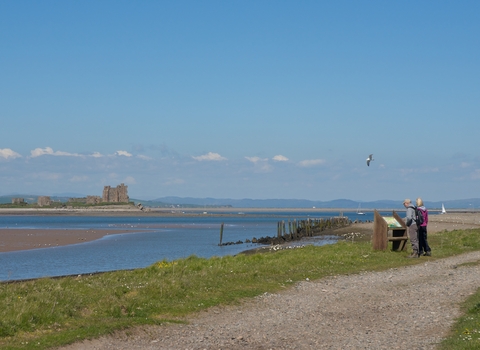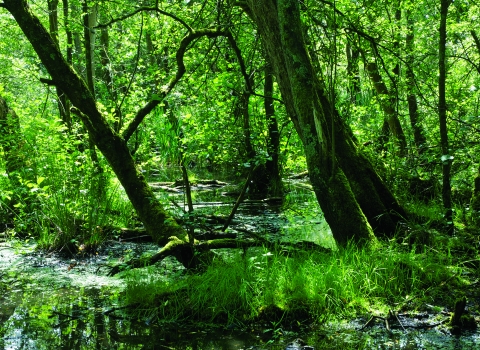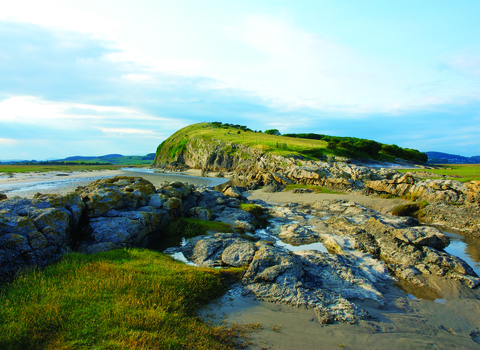
© John Morrison

Arctic tern chicks like this are very hard to spot on shingle © J Sheldon

Eider ducks at South Walney Nature Reserve © John Attiwell

Yellow horned poppy © John Attiwell
Location
OS Map Reference
1:50,000. Sheet no. 96Grid reference: SD 233 655
Getting here
By car:
From either Barrow-in-Furness or Ulverston take the A5087 coastal road to the village of Rampside. From the village follow the road towards Roa Island. Stop about a quarter of the way across the Roa Island causeway and park in the small car park on the left hand side. From here a path takes you alongside the stone causeway onto Foulney Island.
Vehicular access is prohibited on Foulney Island.
By bicycle:
The reserve is 10km/6 miles from National Route 70 Walney to Wear (W2W) and National Route 700 The Bay Cycleway.
By public transport:
Buses run from Barrow-in-Furness and Ulverston to Roa Island.
View on What3Words
Know before you go
Dogs
During the bird breeding season (1 April – 15 August), access is restricted to designated paths and Slitch Ridge is closed. No dogs (except assistance dogs) are allowed on the island at this time to protect birds from disturbance.
When to visit
Opening times
Open all year.Around high tide the nature reserve may be cut off.
Best time to visit
April to AugustAbout the reserve
Wildlife highlights
- In spring - an exciting time with courting eider ducks and terns starting to arrive back on the reserve. Thrift and sea campion are in flower.
- In summer the three species of tern are busy feeding chicks. Supreme long-distance travellers, Arctic terns, migrate vast distances to nest on the island’s shingle banks after spending winter in the Antarctic. Spot these stunning birds alongside breeding common and little terns in early summer. You can see lots of ringed plover chicks as well.
- In autumn the sea aster is in flower. Thousands of Brent geese, curlew, dunlin, knot and oystercatcher provide a spectacle in autumn and winter – look for great crested grebe, red-breasted merganser, cormorant and common scoter offshore.
- In Winter - a great time to spot birds such as Brent geese, wigeon, knot and dunlin. You might also see long-tailed duck, Slovenian grebe or the occasional diver on the sea among thousands of eider.
At any time of year you might see grey seals.
Island of pebbles
Foulney Island is formed entirely of pebbles that were brought from the Lake District to the coast by glaciers during the last ice age.
Once a true island, Foulney Island is connected to the mainland by a man-made causeway built in the 19th century to prevent the Walney Channel from silting up.
The salt marsh to the east of the causeway has developed as a direct result.
What makes Foulney Island so special?
Breeding birds
Foulney Island is perhaps best known for its breeding terns which travel vast distances to nest on the island's shingle banks.
Arctic, common and little tern all breed here. Other breeding birds include ringed plover, oystercatcher, eider, skylark and meadow pipit.
In autumn and winter, curlew, dunlin, knot and oystercatcher may be seen in thousands and great-crested grebe, red-breasted merganser, cormorant and common scoter are frequently present offshore.
Specialist plants
A haven for many breeding birds, Foulney Island is also a great place to find specialist plants.
The vegetated shingle of the island is internationally important with sea-kale, sea campion and yellow horned-poppy all specially adapted to survive where fresh water is scarce.
Sea-purslane, sea-lavender and glasswort thrive in the saltmarsh.
Keeping it special
Foulney Island has been leased from Holker Estate and managed by Cumbria Wildlife Trust since 1974.
Species
Habitat
Contact us
Environmental designation
Upcoming events at Foulney Island Nature Reserve
If there are any upcoming events at Foulney Island Nature Reserve we'll show them to you below.

Support our conservation work on this nature reserve,
and protect Cumbria's wildlife & wild places.
Did you know?
A warden is resident during the breeding season to monitor and protect the birds.



